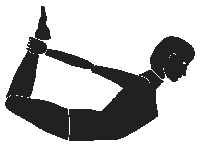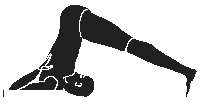Introduction

Factors such as eating more meals away from the home; eating higher fat condensed foods; larger portion sizes; increases in sugar sweetened beverages; decreases in physical activity in schools; more time spent in sedentary activities such as watching TV, playing video games or on computers; urban sprawl and automobile dependency; community infrastructure and safety concerns; and moving from a predominantly blue collar work force to a white color more sedentary workforce; have all been linked to the excessive rise in obesity rates in the U.S. There are simpler methods to estimate body fat. One is to measure the thickness of the layer of fat just under the skin in several parts of the body. Another involves sending a harmless amount of electricity through a person's body.
Results from these methods, however, can be inaccurate if done by an inexperienced person or on someone with extreme obesity. Because measuring a person's body fat is difficult, health care professionals often rely on other means to diagnose obesity. Weight-for-height tables, used for decades, have a range of acceptable weights for a person of a given height. A big part of Fit Together’s mission is preventing overweight and obesity. But it goes far beyond that to include a broader range of topics including healthy weight management— helping people reach and maintain a healthy weight. According to the Center for Disease Control, 57% of all North Carolinians are either overweight or obese, up 82% from 1990 – 2002. Further, 26% of youth 12-18 and 20% of children 5-11 are overweight or obese. Interestingly, each of these NC statistics is significantly above the national average.
Yoga and Obesity
Yoga has an important role to play in the treatment of Obesity. Yoga techniques affect body, internal organs, endocrine glands, brain, mind and other factors concerning Body – Mind complex. Various Yoga techniques can be practiced effectively to reduce the weight and achieve normal healthy condition of Body and Mind. Yoga positions or postures are especially useful to reduce the fats in various parts, especially forward bending, twisting and backward bending asanas help reduce the fats near abdomen, hips and other areas. Also the practice of asanas improves functioning of internal organs, strengthening heart, lungs, kidneys, excretory & reproductive organs. Regular practice builds strength in muscles. Any physical activity will improve mobility and general health. Doing yoga decreases stress, improves flexibility and increases muscle tone and strength.The obese people often have trouble with joint pain; yoga can help by improving the body’s alignment to reduce strain on joints by allowing the frame to bear more of the body’s weight. Yoga also develops your balance, which helps you feel grounded and reduces the likelihood of injuring yourself in a fall. People who are overweight often feel disconnected from their bodies - yoga helps to bring the mind-body connection to the fore, which can improve self-image and acceptance of your body. Most importantly, yoga can help you feel better, both improving your physical fitness and elevating your mood. Yoga has considered all aspects of Obesity like physical, emotional and mental. Regular practice of Yoga and Yoga has different effect on obesity, which is permanent in nature than other techniques for obesity reduction.
YOGA POSES FOR OBESITY
Gate Pose
Gate pose, also known as ptarmigans stretches the side of the body and is very useful for toning the abdominals, improving circulation and increasing the flexibility of the spine. This pose stretches the muscles connecting to ribs, thereby increasing the capacity of the lungs for deep breathing. Stretches the sides of the body and makes the spine flexible. Tones the abdomen and improves circulation helping in obesity.Seated Forward Bend Pose
Relax your body and mind, stretch your hamstrings, shoulders, and spine, relieve stress, and improve your posture and concentration by practicing the Seated Forward BendCows Face Pose
Gomukha literally means "cow face" in Sanskit.Place both feet on the ground with heels crossed under the buttocks. Sit straight and still, the mouth raised. This is called Gomukha-asana, resembling the mouth of a cow. This posture stretches the arms, upper back, chest and the sides of the chest and abdomen. As the shoulder blades are stretched backward the lungs are expanded and as the abdominal muscles are lifted the stomach is toned.Boat Pose
Perform the Boat Pose to strengthen your abdominal area and hip flexor, tone muscles in the midsection, improve digestion, and relieve stress. You can use a Yoga Strap to aid you in holding the pose longer or if you cannot keep your legs straight.The Eagle Pose
The Sanskrit word garuda means eagle. In Hindu mythology Garuda is known as the king of birds. This pose will strengthen the legs, knees and ankles. It stretches and tones muscles of the leg and can help relieve cramps of the legs and also helps in treating obese condition.Mountain Pose
The Mountain Yoga Pose promotes the experience of stillness, strength, relaxed power, and immovable stability associated with mountains. This yoga posture, and coming back to this stillness after other poses, is one of the ways of becoming acquainted with stillness.Warrior Pose One
The Warrior Pose I or Virabhadrasana I improves balance and agility and strengthen your legs, back, and arms. It also targets the chest, shoulders, neck, and abdominal area.Corpse Pose
This pose, the final stage in a yoga session, relaxes and refreshes the body and mind. To come into this posture, lie on your back, arms by your sides, your palms facing up. Breathe deeply and slowly through the nostrils until the pose is completed. Your legs should be straight and together, with your feet rolled out to the sides. Tilt your forehead slightly higher than your chin. Let your body completely relax. Clear your mind of all stress, tension, and worries. Hold the pose for 10 minutes and then release.YOGA ASANAS FOR OBESITY
SUNSALUTATIONS

PRANAYAMA

VEERASANA

Steps
- Take the left foot forward and place the left foot on the floor at the maximum distance from the initial position.
- Bring both the hands together, join the palms and place them on the knees of the left leg. Bend the left leg in the knee in such a way that the thigh and the calf come in 90 degrees. Keep the right leg straight.
- Raise the joined hands up and take them back above the head and then without bending the hands in the elbows, bend the head backward and keep the sight backward down.
- The front leg should be bent in 90 degrees angle and the back leg should be straight. Keep the toes frontward.
- The back leg, the back, the neck and both the hands form a very good arch in this position and this forming of arch is desirable, too.
- The body should be weighed backward and keeping the arms near the ears, the neck should also be bent downwards.
- Start bringing the body forward and place the hands on the knee. Keep sight to the front.
- Straighten the knee and restore the hands to their original place.
- Restore the left leg to its place and take up standing position.
BHUJANGASANA

Steps
- Bring both the hands close near chest and place palms on the ground. Touch the forehead on the ground.
- Inhaling first raise the forehead and chin bend neck as much as possible and start raising the shoulders at ease giving pressure to each Vertebra of the backbone.
- Raise the chest along with till the hands become straight.
- Take the neck back, start normal breathing.
- In the final position keep the hands straight, chest forward. Keep the spine in arch.
- Inhale and exhaling, with the support of the spinal column, start lowering the shoulders slowly with first abdomen touching the floor and then chest, forehead.
- Place the chin on floor and hands back to the original position. Attain prone position.
DHANURASANA
This asana strengthens the abdomen, especially around the navel, and the chest muscles. It improves the flexibility of the arms, shoulders, thighs, legs, lower back and abdomen. The spine also becomes healthy and strong. It is good for relieving flatulence, constipation and menstrual irregularities. It also prevents sterility.
Steps
- Take prone lying position, legs together, hands straight by the side of the thighs, chin resting on the ground. Fold the legs at the knees and bring them on the thighs. Knees must remain together.
- Bring your hands backward and hold the toes of respective legs from the thumb and forefinger of the respective hands.
- Raise your legs a little up and simultaneously raise your head and chest.
- Holding the toes pull the legs towards ears and bring the toes near the ear. Gaze in front.
- While returning to this original position, loosen your hands, take legs backward, let the thighs touch the ground, leave the toes and ultimately bring the legs and hand to the first position
PASCHIMOTTANASANA

Steps
- This posture involves stretching of the posterior muscles of the body.
- While sitting, stretch your legs forward and keep them close to each other. Bend a little forward, make hooks of your fingers and hold the big toes on the respective sides.
- While exhaling, bend forward stretching the trunk along the thighs. Rest your on the knees, which should be kept straight.
- Gradually, the tense muscles can be made supple for securing the complete posture. Inhale and return to the original position
HALASANA

Steps
- Lie on your back inhale to your fullest and lift your legs and trunk first to 30 degree, then 60 degree and finally 90 degree just as in sarvangasana, then take your legs back of your head making it 120 degree and beyond, this process should be done while exhalaling.
- Now rest the toes on the ground behind the head and breath normally, you can use hands on the back for support but ideally both in sarvangasana and halasana hands should be on flooe, palms touching the floor.
- When acquiring the posture of halasana the legs should be at 30 degree from the floor.
- Same process is done in reverse order while returning to normal position.
TRIKONASANA

Steps
- Stand erect with legs together, hands by the side of the thighs.
- Make two or two and half feet distance between two legs and raise both the hands towards each side, so to make a parallel line with shoulder.
- Slowly bending towards right side (lateral) touch the toe of the left leg with the forefinger and middle finger of the right hand and raise the left hand towards sky. Gaze also should be up towards left hand.
- After maintaining it for sometime, slowly return to the second position.
- Now start bending slowly lateral towards left side and touch the toe of the right leg with left hand. Keep pointing towards sky. Gaze should be towards raised right hand.
- While returning back to the original position bring down your raised hand, leave the toes and stand erect with legs together.
Diseases Related to Cancer |
||


